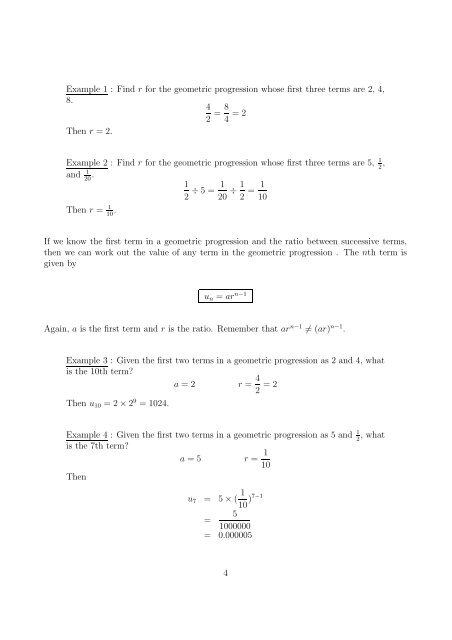Worksheet 3.6 Arithmetic and Geometric Progressions
Worksheet 3.6 Arithmetic and Geometric Progressions
Worksheet 3.6 Arithmetic and Geometric Progressions
Create successful ePaper yourself
Turn your PDF publications into a flip-book with our unique Google optimized e-Paper software.
Example 1 : Find r for the geometric progression whose first three terms are 2, 4,<br />
8.<br />
4 8<br />
= = 2<br />
2 4<br />
Then r = 2.<br />
Example 2 : Find r for the geometric progression whose first three terms are 5, 1<br />
2 ,<br />
<strong>and</strong> 1<br />
20 .<br />
Then r = 1<br />
10 .<br />
1 1 1 1<br />
÷ 5 = ÷ =<br />
2 20 2 10<br />
If we know the first term in a geometric progression <strong>and</strong> the ratio between successive terms,<br />
then we can work out the value of any term in the geometric progression . The nth term is<br />
given by<br />
un = ar n−1<br />
Again, a is the first term <strong>and</strong> r is the ratio. Remember that ar n−1 = (ar) n−1 .<br />
Example 3 : Given the first two terms in a geometric progression as 2 <strong>and</strong> 4, what<br />
is the 10th term?<br />
a = 2 r = 4<br />
Then u10 = 2 × 2<br />
= 2<br />
2 9 = 1024.<br />
Example 4 : Given the first two terms in a geometric progression as 5 <strong>and</strong> 1,<br />
what 2<br />
is the 7th term?<br />
a = 5 r = 1<br />
10<br />
Then<br />
u7 = 5 × ( 1<br />
10 )7−1<br />
5<br />
=<br />
1000000<br />
= 0.000005<br />
4
















